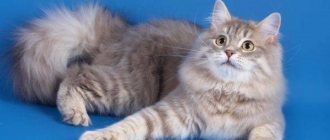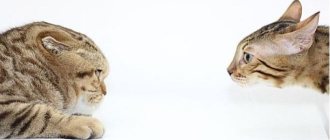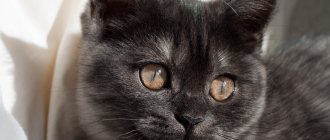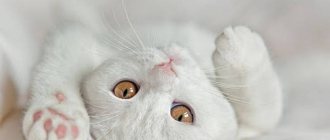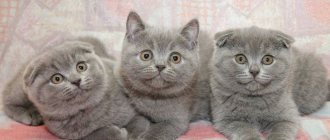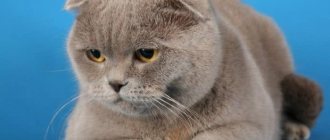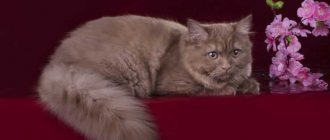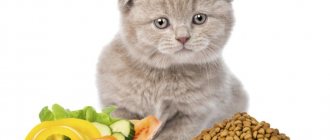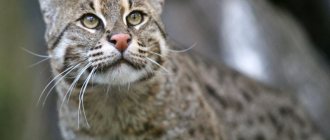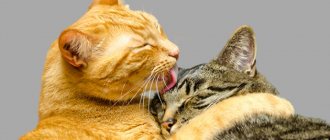Highland fold cats
What kind of breed is this?
Such a rare cat breed as the Highland Fold has been known since 1961. It was at that time that a kitten with ears bent forward was born on one of the Scottish farms located in the Highlands. This gene mutation marked the beginning of a new breed. Over time, the cat, who was named Susie, was matched with a friend with a similar ear structure.
But the first Highland Fold kittens were registered only in 1966, and in the early 90s of the last century, this breed was officially recognized by CFA and TICA. True, breeding Highland Folds turned out to be difficult. Fluffy lumps born from Fold parents had a weak musculoskeletal system and for this reason Highland Folds began to be mated with Scottish Folds (creatures with erect ears). So, in one litter kittens can appear with both floppy and straight ears.
Interesting Facts
British Fold is a Scottish breed of cat.
Interestingly, the first fold-eared cats appeared several centuries ago in the East. However, then they failed to become an independent breed.
Modern fold-eared fluffy kittens appeared in Scotland in 1961 on the farm of William Russo. At first they were rejected and considered a defect in the breed. But these ears gave the kittens an unusually cute facial expression, so the farmer decided to try to breed them as an independent breed. So experienced breeders paid attention to them.
Highland fold kitten
Important! Highland Fold and Highland Straight are different breeds. The second ones have erect ears.
Another fact is the attachment of these cats to family members. As a rule, they consider one person to be their best friend, so they are often bought for children. This is true friendship for life. In European countries, children are taught with the help of these cats. They are present in some school subjects and sometimes even visit students at home. In the USA, children read lop-eared folds aloud, thanks to which the children develop reading skills faster and better.
Highland straight kitten
It is worth remembering that Scottish Fold cats are afraid of heights due to poor development of the vestibular system. They even feel uncomfortable when their owner lifts them off the floor. This has a big advantage - they will not climb on high furniture or climb curtains and curtain rods.
Exterior of a cat
The Highland Fold breed is identified by two small ears, pressed tightly to the head. However, only three to four weeks after birth can you understand whether the kitten is a fold or a straight. After all, up to this age, all fluffy “buns” have folded ears.
Other features of the Highland Fold include the following components:
- The presence of folds on the ears: single, double or triple. With proper quality of such folds, the ears do not extend beyond the head.
- Round body of medium size. At the same time, the charming Scottish cat has a “wide bone” and proportionally developed muscles, so it resembles a kind of “barrel”. An adult cat weighs 4-7 kg.
- The rounded head is characterized by a strong-willed chin, high forehead, smooth stops, and well-developed cheeks. The shortened, dimpled nose of cats is somewhat wider than that of female cats. The ears of females, thanks to their fur, are sometimes invisible, because in their shape they are folded forward and downward. The large, round eyes of the beautiful creatures are set quite widely. The rounded mustache pads also add charm to the muzzle.
- The coat of both cats and cats is elastic, silky, soft with a plush undercoat and is rather medium in length. On the muzzle, limbs and shoulders the hair is shorter in comparison with the body cover. The excellent quality of the wool is a consequence of the presence of Highland Folds, Exotics and Persians in the pedigree.
- The folds' ears and luxuriously fluffy tail have the correct shape.
- A cute, fold-eared Scotsman walks on strong, strong paws.
The color of the Scottish Fold long-haired cat is striking in its diversity. So, you can find red, white, marbled, spotted, smoky, tortoiseshell, lilac and other folds.
It should be noted that at exhibitions the “aristocratic” nature of Highland Folds is emphasized:
- number of folds on the ears: single - the tip of the ear is bent, double - the entire ear (with a small gap), third
- the ear is completely pressed to the head;
- a flexible tail, which should be two-thirds the length of the body.
The reason for disqualification, as a rule, is poor mobility of the animal’s spine and tail.
Origin story
Presumably, the “Persians” owe their long hair, since representatives of the Persian breed participated in selection with the British. The first matings were carried out in the 60s. XX century.
At first, fold-eared kittens were considered a waste, but every year such a marriage appeared more and more often, so in 1986 the first small Highland with folded ears was shown on television in America.
After this, the Highland Fold breed began to be taken seriously and soon the first representatives of the Fold began to appear at exhibitions. But official recognition dates back only to 1993.
Today, finding Highlands is problematic, because they are quite rare, unlike the eared short-haired brothers of the Scottish Fold.
In Russia there are special nurseries where only this breed is bred. But the Folds never managed to gain recognition - many exhibitions do not consider these cats as a breed, or reject participation due to their non-standard color.
Character worthy of an aristocrat
The Scottish Fold longhair cat has a calm and at the same time mischievous character. Therefore, a representative of this breed becomes a faithful friend of all family members, “from young to old.”
Highland Folds are sincerely attached to their owners, they are friendly to strangers, and also find a “common language” with other pets in the house. The “intelligent” nature of the cat does not allow it to tear wallpaper and scratch furniture. And most importantly, the folder has no aggression, so she will never offend the child during the game.
The fold-eared Scot loves to play, but he also knows how to stop in time without getting tired. Also, this affectionate, peace-loving, neat cat does not annoy its owners with loud vocals during the “active season”, it tolerates flights and moving well, and quickly adapts to a new place.
In addition to their docile nature, soft, quiet voice, and beautiful appearance, Highland Folds love to take strange poses, for example, sitting like a “Buddha” with their paws folded on their stomach and at the same time their hind limbs stretched out. The behavior of these cats is interesting to watch.
At the same time, despite his affection for people, the Scottish Fold is a completely self-sufficient person. So, in the absence of the owners, the cat will not suffer, but will occupy itself with something interesting. In everyday life, the folder is quite unpretentious. Among the main requirements of cats of this breed: cleanliness in the house and a variety of tasty food.
It is also worth noting that the Scottish Fold is stress-resistant; it is not disturbed by loud music or loud conversations. On the contrary, Highland Folds like fun and children's laughter.
Description of the breed
Highland Folds have almost the same standards as Scottish Folds, differing from them only in ears and coat. At exhibitions, this breed is presented as one of the varieties of Scottish Fold Longhair cats.
| Body | Small, round and flexible. Animals have developed muscles and a wide chest. In size, cats are slightly larger than cats. |
| Wool | Thick, fluffy and short. Feature – the “collar” and “pants” stand out very well. The wool itself is silky and soft. Rare colors - solid black and white animals. The most common folds are smoky, tortoiseshell, as well as spotted tabbies and harlequins. |
| Head | A wide head is proportional to the body according to standards. |
| Eyes | Widely spaced, round, mostly yellow in color. |
| Ears | Small, pressed against the head, with rounded ends. Folded in half, directed towards the middle of the muzzle. It is the ears that distinguish them from other breeds. |
| Limbs | The legs are short but powerful. The front ones have five toes, the rear ones have four. The tail is thick, bends easily, long, measuring at least 2/3 of the length of the body; with a smaller tail size, cats are considered defective. |
Adaptation of a kitten in a new home
And then the day has come when the fluffy miracle with owl eyes became a member of your family. Looking at such a “paw”, everyday problems are forgotten, and life is filled with bright emotions. But a kitten, like a child, requires care and attention, because in a new place there are different smells, unfamiliar surroundings, there is no mother cat nearby, and he is surrounded by new people.
Therefore, in the first days you should give maximum attention to the cub: play, talk with it (Highland Folds quickly get used to their name) and help them develop a new territory.
You should also thoroughly prepare for the arrival of a fold-eared baby:
- taking care of the carrier, which should have windows that open from the top and a door with a secure lock;
- a litter tray with high sides, which is best filled with granulated wood for babies;
- accessories: for an interesting pastime, a furry tomboy needs a variety of toys (balls, balls, teasers on strings, toys with fillers...);
- play complex: slats, scratching posts, a house, tunnels, which are a single ensemble, perfect for both active growing fidgets and adult cats;
- cozy, warm sleeping place.
And, of course, the health of the Scottish cat largely depends on food. The diet of a fold-eared kitten may include natural products and ready-made food. When taking a small Fold home, it is worth finding out from the previous owners what they fed the baby, so as not to suddenly switch him to food that is unusual for him.
Even before the kitten arrives at its new home, owners should remove objects that could cause injury to the baby. These are, first of all, coils, threads, paints, medicines, wires. As a rule, it takes a little time for a Scottish Fold to get used to it, and in just a few days he will feel like he belongs in his new family.
Character
All Highlands are very pliable and have a calm character. They are friendly towards all family members and absolutely non-aggressive.
They are very attached to the house and to the owner, they love care and attention to their person. But they won’t impose themselves either. They easily accept other pets and get along well with children, although there is a lot of talk about their touchiness and jealousy.
They don’t hide in front of guests, don’t run away, easily allow themselves to be petted and love to show off. The characteristic features of folds are:
- good learning ability;
- curiosity;
- understanding;
- calm;
- good nature;
- sociability.
Caring for Highland Folds
Graceful, beautiful Highland Fold cats do not require daily brushing, which greatly simplifies their care. It is recommended to comb the luxurious fur of such pets once a week. It’s definitely not worth bathing your Scottish Fold often. In addition to the fact that he does not like this procedure, his luxurious hair becomes dull and loses its elasticity from water. Therefore, taking a fold bath once every six months is quite acceptable.
But what responsible owners must do is to clean their cuties’ eyes and ears as often as possible, because dirt accumulates in these organs, which can cause infection.
HISTORY OF THE BREED
Scottish Fold cats were bred in the 70s of the 20th century.
Breeders then crossed them with the British and Persians. And everything would be fine, but from time to time shaggy children were born to short-haired parents. For a long time, breeders were faced with the question of what it is: a special subspecies of the breed or a “production” defect? Therefore, they did not want to recognize the breed, but later this still happened - and in the 1980s, many felinological organizations called the Highland Fold a separate breed, almost 10 years after their short-haired counterparts were recognized. Today in nurseries, Highland Folds are much less common than Scottish Folds and Scottish Straights. But there are also breeders who specialize specifically in breeding Highlands, understanding how interesting and royally beautiful this breed is.
However, even today, not all felinological organizations recognize it, and most of those that do do not allow color-point cats to participate in exhibitions.
Proper nutrition
To maintain a healthy condition and for the activity of a cat, it is necessary to feed it well.
There are the following ways to feed Highland Folds:
- natural, including products such as yoghurt, fermented baked milk, low-fat cottage cheese, boiled poultry, boiled sea fish;
- dry and wet food, which must be consumed with fresh water;
- mixed feeding, consisting of both natural products and dry food plus fresh water.
By the way, with a mixed diet, you cannot mix both types of food in a bowl. Each type of food should be served in a separate plate.
Small folds (up to 4 months) are fed 4 times a day, then the kitten is transferred to a three-time meal plan, and starting from 8 months, the Scottish Fold eats 2 times a day. The main thing is not to overfeed your pet, because excess weight will negatively affect the well-being of the fold.
Breeding
If Highland Fold breeders are thinking about breeding the breed, this can only be done by adhering to a number of rules:
- Under no circumstances should two lop-eared individuals be crossed. With such inbreeding, kittens with various kinds of genetic pathologies will be born. You can consider Highland Straight as partners. This option will be ideal.
- The female becomes ready for mating and childbirth only after reaching 1.5 years of age. It is best if the first mating process occurs during the cat’s 3rd heat.
- The cat-male meeting should happen on the second day of estrus.
- The female and male must be vaccinated and treated against parasites.
- It is better if the color of the partners is approximately the same, and the size of the cat exceeds the size of the female.
Scottish Fold cat health
The only serious problem with the Scottish Fold longhair cat may come from its musculoskeletal system. After all, the gene that created the unique ears had a negative impact on the cat’s joints. The Highland Fold does not have any other significant diseases, and with proper care, as well as timely vaccination, an animal of this breed will live at least 15 years.
By the way, when choosing a baby, you should pay attention to his tail, which should not be thick and short. After all, such indicators indicate the predisposition of a small fold to joint ailments.
How much does a kitten cost?
The cost of a Highland Fold kitten depends on where it was purchased. Thus, the price for a kitten from a nursery with a certain package of documents can reach up to $1,000. But a cute, handsome dog with folded ears and a cute face without an official pedigree costs much less (on average $100).
The Scottish Fold, like the Siberian cat, is an ideal family pet. Therefore, if you dream of a devoted friend for yourself, your family, as well as a faithful companion for your dogs, hamsters, and rabbits, then purchasing a Scottish Fold will be the best choice.
Video about the Highland Fold cat breed
Care and maintenance
Cats of this breed do not require special care. However, the breed is long-haired and this should definitely be taken into account.
The coat needs to be brushed regularly and the cat needs to be washed to keep it healthy and beautiful. To comb long hair, your pet must have its own comb.
Brushes with fairly sparse teeth made from natural material are best suited.
The Longhaired Scotsman should be brushed daily, and more often during the shedding period, twice a day. It's okay to miss a day, but no more. Brushing is a pleasant and useful procedure for these cats; the teeth massage the skin, thereby improving its blood supply, and the coat grows healthier, softer and silkier.
The Highland Fold should be bathed regularly, but not too often, about once every 6 months. Firstly, due to water procedures, the protective fat layer is washed off from the skin, the coat becomes dull and loses fluffiness from frequent washing, and secondly, like most domestic cats, the Scots, to put it mildly, have a cool attitude towards water. The washing procedure is stressful for them, and in order to reduce its level, you need to accustom your pet to bathing from a very early age. He will not get used to it, but there is a chance that he will tolerate the procedure a little more calmly.
Another necessary hygiene procedure is cleaning the ears. This should be done approximately once every two weeks, being careful not to damage the ears. A regular cotton swab is suitable for the procedure.
Kittens get used to the litter box quickly: it’s enough to show the litter box a few times and explain to the cat what it’s for. Highland Fold owners should carefully monitor the cleanliness of the potty, since by nature these cats are very neat and clean.
If there is a strong odor or old litter in the tray, they may well refuse to use it.
Highland Fold cats, like other domestic cats, need to have their nails trimmed and their eyes and teeth cleaned regularly. At 2 months you need to get vaccinated against viral infections. Further vaccinations are given according to the schedule. In veterinary clinics, you can ask for a special reminder or develop an individual schedule with your doctor.
